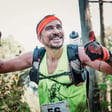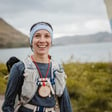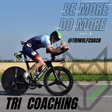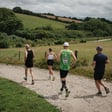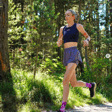Become a Creator today!Start creating today - Share your story with the world!
Start for free
00:00:00
00:00:01

Soar Today | Strength & Conditioning for Runners
In this episode we catch up again with the team from Soar our Strength & Conditioning partners.
Listen to this conversation with Alex and James as we discuss:
What are the most common running related injuries and what can we do to help reduce the risk of these injuries?
Why rest alone is not enough to help an injury recover.
Specific strength exercise recommendation all runners should do.
What is occlusion training and should you do it?
And more....
Transcript
Introduction and Guest Welcome
00:00:01
Speaker
Welcome James, welcome Alex. How are you both? Good, thank you. Thanks for having us. Very good, thanks. Pleasure, thank you.
Upcoming Trip and Scheduling
00:00:11
Speaker
Just before we hit record, James told me that you're both going away tomorrow. So thank you very much for giving me your time at this moment when you're very busy getting ready for your holidays.
Paddy Buckley Round Overview
00:00:24
Speaker
James also mentioned that he's for listeners that he's running the Paddy Buckley round
00:00:31
Speaker
Do you want to give us a quick overview what that is, James, for your holiday? Yeah, so the Paddy Buckley round is...
00:00:39
Speaker
the Welsh equivalent of probably the more well-known Bob Graham round. So it is a 24-hour round, so you have to essentially complete a loop of, I think it's approximately 60 miles over 47 peaks in Snowdonia and end up back where you started. So I'm just going to start Clamberis and go over the Glidders, down into Yorgon Valley, over the Kenedi, down to Capil Keurig,
00:01:08
Speaker
over Mol Shabbod all the way around, so I think you end up in Nampmore, then you go over
00:01:18
Speaker
the Nantal Ridge over to Snowdon and then I will be finishing off with Snowdon probably in the middle of the night and then back to Humberis hopefully within the 24 hours. But the challenge for me in part was to do it solo so I'm going to be on the hill by myself even though my wife is going to help me out at road stops.
Support System During Challenges
00:01:42
Speaker
Your lovely wife letting you trot off and do that for the day whilst you're on holiday. She'll be looking after three kids as well as doing my road support. Wow, I love it up there. Like I mentioned just before we press record, we were there last week for the Forest Coaster up in them. Betsy Coad, I love that part of the world, it's beautiful. So enjoy, I look forward to hearing how you get on. Thank you.
Running Injuries and Prevention
00:02:12
Speaker
We'll get straight into it because this time we're going to talk about, well, I think we came to this because so often runners miss the strength training, which is what you're all about, and then they only pick it up after they've got injured. Is that a fair comment? I would say so. I think we're all about prevention, and prevention being better than cure, but I think
00:02:42
Speaker
most people find us because they've had some issue previously with injuries and the way in which we approach it all is very much a more holistic approach rather than just thinking about the injury itself. It's the mechanisms or the most likely reasons for you to be becoming injured. So that's why people kind of stumble across us in a
00:03:09
Speaker
hopefully in an attempt to help prevent them with injuries. But obviously, 50% of runners every year get injured. So at some point, it's a flip of a coin. If it were not this year, you're going to get
Understanding Overuse Injuries
00:03:22
Speaker
injured. So you kind of find us when there's an issue. But hopefully, we can push that to a more proactive approach to it.
00:03:35
Speaker
So what are the most common running related injuries that you see when people come to you? Yes, it's a good question. It's pretty much the foundation of how, excuse me, how sore and ready to run came about. The vast majority of injuries, 80% of all injuries are
00:04:01
Speaker
overuse rather than traumatic injuries. So overuse is the continual loading of that area of the body and that repeated loading goes above what the body can tolerate and therefore you get an acute or a sudden injury. Unlike the traumatics, which are about 20%, which are things like rolling your ankle while running or
00:04:31
Speaker
the really unfortunate things of being hit by something or falling over. So 80% of those overuse injuries are overuse injuries are 80% are clearly the most dominant in that. The 80% of those injuries, which is really interesting, happen at the knee or related to the knee or below. So you can see
00:04:58
Speaker
that quite quickly when you go for overuse, then down to a lower limb and knee and below, you can see quite quickly that there's an awful lot of stress going on around those areas. So kind of the most common ones are like runner's knee, patella and Achilles tendinography or tendonitis, plantar fasciitis, ITB syndrome,
00:05:20
Speaker
shin splints and hamstring tendinopathy-based injuries. They account for the vast majority of them and probably runners knee, which is kind of
00:05:32
Speaker
Aching pain around the kneecap and the femur is probably the most common. The literature would suggest this is the most common injury. But they're all basically, when you look at anything which involves the tendon and an inflammation of the tendon or the fascia, which is the plantar fasciitis, or a bony stress reaction like shin splints, that is all over use.
00:05:58
Speaker
based symptoms so those when you get a shin splint is because the bone has been pounded upon more than it can actually tolerate. When the tendon starts to inflame it's because the tendon is working more than what it can normally tolerate and when a muscle starts to behave inappropriately or in a dysfunctional point of view it's
00:06:23
Speaker
It starts, again, that's a stress related response. So they're, they're the kind of the main injuries. It's not to say you don't get injuries elsewhere. There's clearly hip, low back injuries as well. The way we view it and in the lens that we view it is, is what happens below the knee. Well at the knee and below, which almost cascades the injuries up above the knee. So often the back or the hip aren't
00:06:51
Speaker
the cause is they're just the symptom of something
Personal Injury Experiences
00:06:54
Speaker
that's going on below that. And it's often just the ability to manage all of the forces as you land. And if you're doing lots of running in a 10K, I guess you probably would do 20,000 steps in 10K, that's 10,000 steps per foot. And on that, you can probably
00:07:18
Speaker
see how quickly an overuse injury can occur if you've got a slight dysfunction in a tissue from the knee downwards in the body. Anything to add to that James?
00:07:33
Speaker
I was going to say, from my coaching clients, the ones I see a lot and suffer from myself are the runner's knee and actually quite a lot of Achilles tendinitis or tendinopathy, whatever you want to see. But when I chat to Alex about my runners, those tend to be the bits that we focus on. We'd see a lot of threads about plantar fasciitis. I think about the
00:08:00
Speaker
the injury threads that come up, or they seem to be the one that get discussed the most. Is that because it's so difficult to get rid of, or why would you think that might be? Yeah. One, because it's like a red hot poker going through the sole
Plantar Fasciitis Discussion
00:08:19
Speaker
of your foot when you get it. This is really random. I didn't get it through running. I was working with Team GB in the Rio Olympics,
00:08:30
Speaker
I was heading up a training facility at a facility just outside of the Olympic Village, but I was there for six weeks. On average, I was doing about 25,000 to 30,000 steps a day, which was probably double what I normally do. I came back
00:08:48
Speaker
And again, you get free, you get free, Eddie, that's kit, which why you're part of the team, but it's not the normal trainer I normally wear. And I'm, I think the combination of changing footwear and
00:09:02
Speaker
overloading the number of steps I did. I got plantar fasciitis and the reason why is just that my body wasn't tolerant of the sudden change or the overload of that. So the reason why I think people talk about it is because it probably wakes you up in the morning. When you first get out of bed it's probably at its worst and it's primarily because when you're resting you have a slight
00:09:29
Speaker
stiffening of your muscle tendon unit so if you think the muscles one part the tendons the other part when the kind of the fascia underneath the foot is kind of linked to the ton of tendon a bit so when the muscle starts to relax it just pulls it a little bit and suddenly creates a bit more tension and it's actually when you
00:09:47
Speaker
spend a bit more time on your feet and you stretch it out, it tends to alleviate a little bit, it doesn't get rid of it, but it alleviates a bit of it. So I suspect because it is so blooming painful in non-running activities that it really becomes a big conversation. And it's really difficult to get rid of as well because there's
00:10:11
Speaker
there's obviously a range of movement piece there, but there's also a kind of a, it's what your calf and the kind of the musculature around the front and the back of your lower leg actually can do to kind of change that. So it's about to get into scientific on it that if you have a muscle which doesn't contract or shorten and lengthen effectively, you often get a lot of range of movement through the fascia of the foot.
00:10:41
Speaker
So you get that range of movement. So the body cheats, it finds the easiest way to move. And if you don't get the movement through the muscles of your lower leg, it will find the tendon or the muscles above or below. And often the fascia of the foot is what becomes the victim of that. And so often when you're treating the pain, you don't necessarily treat the cause of why that's happening, which is often a bit further up the leg.
00:11:06
Speaker
And I think that's probably why it's really stubborn if you don't do it.
Aging and Recurring Injuries
00:11:12
Speaker
And I know now after that event, that was what, seven years ago, seven years ago, if I still don't do single leg calf raises two, three times a week, after two weeks, I will quite quickly get it after doing some training. So you do have to stay on top of it. It's one of those, the same with all the kind of the tendon
00:11:37
Speaker
tendinitis or tendinopathy-based symptoms. If you don't stay on top of these things, you can quite quickly turn back into a negative state of it. If it takes two weeks for the symptoms to come back on again, it might take four weeks to alleviate it. It almost takes twice as long. That's a rough rule.
00:12:02
Speaker
a physiological rule, but it's a rough rule of if it takes us a number of weeks to get into a symptom, it will take almost double that to get back out of it. Yeah. Do you ever see people as the age perhaps have had an injury in their 20s and then 20 years later, the same injury returns, even though they've had a huge gap of it being completely fine. Do you see things like that? Is that a thing?
00:12:30
Speaker
It definitely is a thing from working with athletes, but also from personal experience that I had a L4, L5 significant disc irritation when I was 21, 22. And that's when I still had rubber and magic in my body. And you could sort of do very little and get over it and kind of kept on top of it. And then as I kind of transitioned
00:12:58
Speaker
during COVID set this business up and was probably more sedentary and there was obviously more restrictions. Like I felt it came back again. And the last 12 months I've had on and off sciatica based because of that irritation from over 20 years ago. But you see that the best predictor of future injury is previous injury. So if you had a previous injury in a site,
00:13:28
Speaker
there is a greater opportunity to injure that again. And some of that is because of poor rehab. But some of it is because you've just changed the structure of the tissue. And that sounds really, really, really kind of abstract. But if this is as a kind of a kind of
00:13:52
Speaker
easy way to
Training Approaches and Balance
00:13:53
Speaker
look at it. If everything is supposed to be uniformed in your tissues and when you're young and you're healthy, everything's nice and it kind of moves nicely. When you become Indian, it kind of gets a bit more gnarly and so on. So it just isn't like what it was before. And if you don't rehab properly or just over time, your tissues just become like that. So if you've got a minor frailty in that space, that kind of grottiness can come back again because
00:14:22
Speaker
aging is another factor in predicting injury as well. Yeah, well like your natural strength deterioration as you age and your mobility reduces as you age. So if you've got those slight changes in structure like you're talking about, then I guess that would amplify again. So it makes total sense. Yeah. And I was listening to a radio show on LBC a couple of weeks ago that was talking about aging.
00:14:52
Speaker
I think one of the questions was asking about how does an Olympic champion four years later not even make the final? And there was lots of hearsay about what it was, but a professor came on and started talking about aging and just the effects of aging on, it's really depressing talking about this as you get older, but your muscles just don't function as appropriately, your tendons become
00:15:21
Speaker
less compliant and stiffer and they don't work like they did before. Your joints have taken more of a pounding so there's less kind of synovial fluid or castles protecting them and all of these things have these kind of minor effects but when you aggregate them all together it kind of
00:15:41
Speaker
changes the very way in which you move. And you try and as I say, the bodies, when I say lazy, I don't mean it in a negative way, it just finds the easiest way to move from A to B. And if you make a small, small chain somewhere else, it will, it will move slightly differently. And that just puts more load on another part of the system. It's like a car, like, you know, if you change your, you change the,
00:16:07
Speaker
the amount of power a car can produce, but you don't change the brakes. What you end up doing is having an inappropriate braking system for a very high accelerating system, or you change the weight of the car, you put more weight onto the left-hand side, then the wearing of the tire becomes more than if it isn't balanced with the right-hand side. It's exactly the same for us. Our body just finds a way of moving and suddenly it becomes a point where it's like, no, I'm not having that anymore.
00:16:35
Speaker
Yeah. And like you said before, it makes its way up the chain, doesn't it? It makes its way up the chain and refers to that as well. Have you seen the guy, there's a guy doing the rounds on YouTube at the moment and he's trying to reverse his age and he's taking like hundreds of pills a day. Have you seen him? I haven't seen him. I've heard someone was talking about him in the training center yesterday.
00:17:02
Speaker
Yeah, I think he's on Diary of a CEO podcast this week, I just saw, but I have actually seen him on a different podcast and he is literally trying to reverse his body, but he's taking like millions of pounds worth of different tablets and I was just like,
00:17:22
Speaker
wow is that you know is that worth it and he only drinks he only eats in certain times and he has three mils of alcohol at seven o'clock every morning and night anyway i'd rather aim gracefully you're delaying inevitable that's a problem isn't it yeah he's not living longer it just feel it'll just feel to him like he's living longer because it's so boring
00:17:50
Speaker
Yeah, there is a balance to be had, isn't there, around like what you can do and what's actually just kind of like that kind of sweet spot of, because you still want to live a life, haven't you? And this is the same with training, isn't it? Like you could spend your life, you know, definitely I was working with yesterday. I had a conversation with the team at the end and I was like, the amount of training this person is doing is significant and
00:18:17
Speaker
I'm not sure they need to be doing that amount of work and then you extrapolate that back to a human. That's basically six hours of exercise a week of which four hours of that is probably more remedial corrective and supportive rather than performance focused.
Stress Management in Injury Occurrence
00:18:35
Speaker
I was like, well, I'm not sure anybody wants to spend that amount of time
00:18:39
Speaker
and which is again why running ready to run is the setup to do the minimal dose response to get the most for your buck really. Yes, which in today's world is perfect isn't it, how busy everybody is. So you went into that then really but how in terms of how these
00:19:01
Speaker
injuries are usually sustained, but is there a pattern that you see regularly for people with these overuse injuries? Yeah, there are. They're all slightly different, but there is generally the exact same reason that this occurs. And if you take away, people say, oh, that's footwear, it's training, all of that.
00:19:29
Speaker
ultimately comes down to one or two physiological responses, which is you are placing a certain tissue or group of tissues, whether that's the muscle, the tendon, the bone, under more stress than it can cope with. And that fundamentally is a pattern. So if you change your footwear, like I described when I was in Rio, for instance, that actually had an impact on it. But fundamentally, my
00:19:58
Speaker
my tissues were unable to tolerate what was going through there. So that's the first physiological thing. It's just stress. It's overloading that. The second pattern we see is you'll have one or two things occur. You'll get an injury at that site, or it will be an injury above or below.
00:20:28
Speaker
which is why it's really important when you're doing the above and below that the where the where the limitation is, because the body's offloading it into one of those spaces, which is why, when we look at this, you have to take a much more holistic approach to to this. So if you have a calf issue, you may not manifest itself as a calf issue, which is why you have to look at all the other assessments that we do above and below, because you'll see a deficit, which may exist. And
00:20:57
Speaker
too long in my career, it was like, well, I got a hamstring issue. Let's just go now the hamstring. And then actually, when we looked at it, it wasn't a hamstring problem. It was a, it was a loading issue around the calf. And actually they were trying to offload the calf. And by doing that, they put more load through the hamstring. Funny enough. And so it's, that's what's really important to, to do that. So they're, they're kind of the two kind of patterns that you see. One is, is overload.
00:21:25
Speaker
two is it's a site of injury or the injuries above and below and I suspect the third bit pattern I see and this is more with those who have who don't do regular physical activity in terms of physical strength training or supportive strength training around that
00:21:52
Speaker
is that they have long periods of absence or rest between training or they received an injury and they haven't and they just rested it so the tissue hasn't or the tissues of the body just haven't adapted and I think we've spoken about this a fair amount but the key thing for me is what ends up happening is you rest because you feel pain
00:22:21
Speaker
The pain is a signal to say that something around that area is not working and you stop until that pain goes but what you've done and this is what overload does when I was talking about this nice kind of uniformity as a kind of abstract idea.
00:22:40
Speaker
you've the pain is kind of created and the injuries kind of created there and all you've done is just left it and it's just no there's no signal now to say that that's there's an issue there so you go back and load like that rather than loading back like in a kind of more uniform position and the only way you get uniformity is through training and actually changing the tissue again to get it back to normal so that the third pattern is when there are long periods of
00:23:09
Speaker
uh not attempting or deliberately not attempting or unaware of not attempting to make a change to that tissue after injury.
Exercise Selection for Prevention
00:23:19
Speaker
That's one of my bugbears with some of my fellow runners is the the wish to rest and then come back and then the same thing happens again and they rest and come back and there's where there's one guy I run with who has had knee problems on or off all year he rests comes back runs for a few weeks
00:23:39
Speaker
knee hurts, rest, comes back and it's just a cycle that at some point you need to break the cycle and actually rehab whatever is wrong because I think resting is often not the solution here. It will take the pain away. It won't take the problem away.
00:24:04
Speaker
I can totally, the other sort of real world example is coming back to injury sites. I went to see the physio yesterday because I've got pain in my knee. Guess what? It's not my knee. It's a weak glute that is causing everything to tighten up and pull my kneecap out of line and then my knee hurts.
00:24:25
Speaker
and it's just cascading down. In this case, it's coming down the chain to hurt my knee. So the site that hurts may not be the site where the work's needed. Yes. How does that point interact with the programme and specifically the exercises that people have to do as part of the assessment? Yeah, good question. So you'll see
00:24:54
Speaker
So the four exercises that are included within the risk report have been selected to target the areas which we know are most likely to be affected. But we also know they're kind of proxy measures for other areas. And I was saying to James this morning that actually we have assessments for
00:25:22
Speaker
pretty much everything. I think when we were talking about the exercises required for the course opposites alongside this, I think there are 15 different assessments that we use. If you did the whole shebang, that would be it. But we've chosen four, which we think are much more representative of the vast majority of people. And knowing that when we've done the data analysis on the assessments,
00:25:50
Speaker
that tends to be the trend is if you're good at one, you tend to be good at all. If you're average at one, you tend to be average at all. If you're poor at one, you tend to be poor at all. And that's true for about 90% of the people.
00:26:05
Speaker
that we've tested and that gives us an idea that if you have a poor single leg calf raise score the chances are you're going to have poor knee to wall range of movement and some of the other assessments around this. If you have a poor hamstring bridge for instance then you are likely to have poor knee like a quad
00:26:34
Speaker
quad capacity and poor hamstring range of movement. And you tend to see all these things kind of moving in unison as they get better. So we've selected ones which we think are, well, one, they're really easy to do and it can be done with no instruction or no person in front of you. You can do them at home. But two, ones that we think are important enough to be representative of the lower body. And you'll see that they're all
00:27:04
Speaker
either below the knee or directly around the knee. So the hamstring and the quad stretch obviously have the knee component within that. So we know that they're all covering the vast majority of the areas that we know are high risk.
Immediate Injury Response
00:27:23
Speaker
Yeah, cool. So if anyone listening then is unfortunate enough to get injured, what's the first thing they should do?
00:27:35
Speaker
While we've been bashing resting, the first thing is actually you do need to rest. And you've probably heard of rice, rest, ice compression elevation. There's also this, call it price now, which is protect, rest, ice, compression, elevate. And the idea is
00:27:57
Speaker
that is trying to remove the immediate acute responses to the pain. So often with pain, you'll get an increase in heat, increase in inflammation, and a protection of the area to try and avoid movement. And that's the body telling you that there is genuine distress in that space. So that would be the first thing is to properly offload it.
00:28:24
Speaker
If we've been really clear with ready to run that, it's not for rehabilitation, it's about rehabilitation and protecting. So it's about knowing what the injury is before you can start making an effective plan. So often the best advice is to go and see a physio who will be able to
00:28:51
Speaker
As James gave his testament a second ago, it's not the knee, it's something else. So obviously when you feel it's a knee, you try and do, you know, if you go and Google knee pain on for runners, there's 5 billion Google hits and you can choose any one of those things which can be misrepresenting or all that, but actually getting genuine advice around what that is.
Work Capacity in Recovery
00:29:15
Speaker
Once you've got advice of what it is, the pain is no longer a problem.
00:29:21
Speaker
then the two things we talk about are around range of movement or flexibility and work capacity. And work capacity is basically loosely like strength endurance. We don't need to be super strong, but we do need to have the ability to repeatedly load a muscle or tendon submaximally for long periods of time, which kind of sits right in this work capacity base.
00:29:50
Speaker
world of lots of repetitions. So the programs we write actually go up to fairly hefty numbers of repetitions because we know that if you can do 45 repetitions on a single leg calf raise then your calf is potentially not a limiting factor to you becoming injured in the future. So the idea then will be to
00:30:12
Speaker
start on low intensity loading to increase your work capacity. So we often try and get people on, so if it's your left leg that you might have an issue, we try and do double legs so that you take a little bit of the load off that and then you move on to the single limb. We look at ranges of movement as well and just make sure that the joints and the muscles can have a freely movable
Personalized Training Plans
00:30:40
Speaker
uh, plain plain of access so that they, they're not limited. So excuse me, that they're not limited by, um, by any, any type of restriction. And then it's just like, we, we use this term kind of like habitual capability, which is if you can run and put, let's say three times body weight through, through your body, for your calf muscle while you're running.
00:31:06
Speaker
then your training needs to train the muscles and the tendons to be able to deal with three times body weight. So the example I often give is that doing three sets of 10 is not going to touch the size for most people because you're about to do a 10K and you're pushing more than one times body weight through there. So actually, as you get to the higher volumes, the body doesn't know
00:31:36
Speaker
load or it doesn't know the amount of load that's going through it but it does no stress and it does no strain and in those latter repetitions you can force the muscles and the tendons to behave almost identically under stress.
00:31:55
Speaker
as if in running as well, and you can build up a capacity to deal with that. So that's why the volume for us becomes really, really important. And just to add to that point, Alex, that's why the risk assessment and the personalisation is so important.
00:32:13
Speaker
important because that is what then sets how many repetitions we're going to ask someone to do. And if you ask someone who's at a very low risk of injury to do a small number of reps, that's not going to
00:32:28
Speaker
help them in any way. If you ask someone who's at a high risk of injury to do a very large number of steps, that's going to have the equal and opposite problem is either unachievable or is actually going to injure them. So that's why, you know, sort of advice that you do three times 10 of this or three times 12 of this doesn't work. It'll work for a group of people, but for, you know, vast majority, it's either going to be too much or too
Misconceptions in Strength Training
00:32:55
Speaker
too little. So you need to scale things to get this stress that Alex is talking about to get the muscle stronger. It's really interesting because if you talk to, I bet
00:33:09
Speaker
However many runners, or people in any other sports, endurance sports, and they think about strength work, that is the kind of norm, isn't it? That eight to 12 rep range, perhaps you'll work it with a weight for four to six weeks.
00:33:28
Speaker
your muscle will adapt, you'll get a bit stronger and you'll increase it by two and a half kilos on each side or similar to the volume of reps that you're talking about and how you just explain that in terms of if you're running a 10K or you're running a half marathon or you're running a marathon.
00:33:44
Speaker
and you know that your body weight increases because in my mind, and you'll see people talking about this all the time, but my head in between my shoulder blades felt so heavy doing my marathons. I hadn't done any upper body strength training, but after I thought, well, I probably should have done because I was aching and the pain. So high reps in all those different areas makes complete sense.
00:34:13
Speaker
But how many actually do that? How many people actually do go to those kinds of levels of reps within a set? You can ask James, because James has hit his week 12 and has got close to some of that volume already.
Balancing Strength and Endurance
00:34:35
Speaker
So what sort of volume are you doing week 12, James?
00:34:38
Speaker
So I was up to about nearly three sets of 40 reps for some of the exercises. So that, you know, so that's quite a lot. And, you know, just to be clear, you don't keep scaling up the amount of exercises you can go to a more difficult exercise. But actually, you know, the whole point of, you know, kind of this prehab or conditioning or whatever you want to call it is, you know, the way you do it is lots and lots of reps.
00:35:04
Speaker
at a low, at body weight, essentially, or very low intensity.
00:35:13
Speaker
It's probably not the podcast to go into, but there are various different types of strength. And Alex just talks about maximal strength and how you train for that's one thing. A lot of the three by 12 with as heavy as you can do, 70% of your one rep max or whatever it is, a lot of that's to stimulate muscle growth, as in get big, get muscly. And actually as a runner, that's not necessarily what you're looking
00:35:40
Speaker
four, you don't want big muscles, because you're just going to have to lug around, unless big muscles are giving you a little more power, you just have to lug around more weight. And that's why, you know, it's important to kind of Alex, I think you always talk about the outcome, it's important to try to know what the outcome you're trying to achieve is. And I think too often with strength training, people are not necessarily thinking about the outcome, they
00:36:07
Speaker
they want from it. They're doing it in the sort of medium reps, medium weight, which builds muscle. It's not ideal for runners. I'll add to that as well, that James is not the nail on the head there. He should become a strength coach.
00:36:30
Speaker
The, um, the second bit, I think, which is really important, which it's alongside that when you look at the, the type of training people do when, when you are going to the sets of eight to 10 or sets of 12 repetitions, the thing that stops them from loading that exercise. Isn't often isn't going to be the tissue or the muscle, which they're trying to target. So give you an example that when you see people squatting.
00:37:00
Speaker
Most people, their quads are strong enough to probably have two times their body weight. That's roughly about right. So if you weigh 60 kilos, you should theoretically be able to do 8 to 10 repetitions on 120 kilos on the squat. Now, I guarantee it's not the quad that stops them from loading 120 kilos on that. It'll be their back.
00:37:30
Speaker
So suddenly you're loading to the most limiting factor of your body. So you might end up, when you're squatting, putting 110% of stress through the back's maximal capability and only 70% of stress or 60% of stress through the quad. So the quad's just not getting enough stimulus. So suddenly you're just training
00:37:55
Speaker
and you're training at what the back can tolerate. And this is often the real issue with strength training, that the areas that we are targeting are limited by other parts of the body that can tolerate that. Our body's the same often when you're trying to load the back or the chest, it's the biceps and triceps which are limiting them. So the ability to load really heavy isn't, you're not being limited by what your pec or your lapped or so I can lift, it's because your bicep or your
00:38:23
Speaker
tricep is really weak. So actually, you're not loading what you're thinking you're loading. And this is the big kind of myth or the big unwritten or unspoken rule around strength training that it has to be at a genuine absolute intensity, not a relative intensity, but people say, oh, you know, it's, you know, relative to what I can do, I may progress. Well, that's great. But if you think that your quad can do two times your body weight and you've got really question
00:38:53
Speaker
what a single leg split squat with 40 kilos on your back is doing or a back squat with 60 kilos on because it's not targeting the quad anywhere near as much as what people think it is. Which is why when you go to the higher repetition based work, you're not limited by the body's ability to tolerate the loading in other parts of the body and you can directly load the tissue, which is you're trying to target.
00:39:20
Speaker
and you can target it really effectively by body weights and doing high volumes. Now, I'm not saying a high load or heavy stroke training or maximal strength training isn't important, but clearly it is. And if you ever came in and watched me coach the athletes I do, you'll see it's a big part of our training program. But for the vast majority of people, they don't need it anywhere near as much as what they think they do. You do need to be strong, but you get that through
00:39:48
Speaker
through the top training we're suggesting. But you just don't have the availability of equipment, facilities, expertise, or if you do, you have to pay quite a significant price for it. And our job is to try and which is why we've come back down to this idea of work capacity, strength, strength, endurance type of work, and range of movement, flexibility work is like, if you can do those two things anywhere, you're doing
00:40:13
Speaker
you're getting 80% of the outcome that you need, and you don't probably need to get that last 20%. And
Accessible Exercise Routines
00:40:18
Speaker
if you do, then you'll be training three or four hours a day to get that. That's a really long-winded explanation to it.
00:40:26
Speaker
Now it's really interesting, I had a couple of thoughts. One is that the reason why you see some people walking around and they're all jacked in their upper body but then they have really skinny legs. That came to mind. Because I have a friend like that and we're ribbing for it. So perhaps he's back to week and he's doing his squats and it's not loading his legs. And then the other one is though, you can actually
00:40:52
Speaker
You can be kinder to yourself, can't you? You don't have to hammer yourself and you can be kinder to yourself and have it as a real complimentary thing to, and I think this comes, we're going back to the age thing as well, but if I think that's trying to compete when you're younger, you kind of hammer your own body.
00:41:11
Speaker
Now I'm in my 40s, I want to be kinder to myself because the amount of recovery time takes longer, all of the things that come with age. So via your program and via educating yourself and listening to the things that you say and you realize that
00:41:32
Speaker
you can be kind to yourself, you can still get stronger, you can get more mobility, you can get more strength, you can improve. And you don't have to annihilate your body doing it. Yeah, yeah, agree. And I think sitting alongside that
00:41:51
Speaker
it's not just about being kinder to yourself, it's making it more accessible as well. So as soon as you say, well, actually you can use your body weight and you can do it at home or you can do it in the back garden or you can do it at the gym if you want to. But ultimately you're saying like it's available to everybody and you're not limited now to just having to go to the gym. And I think fundamentally that's a really, really important philosophical
00:42:21
Speaker
stream within SOAR, that's one of the things we genuinely believe that we need to make everything we do accessible, which isn't just about the cost of it, but it's the ability to literally do it anywhere with very limited equipment. I think we could probably get away with just having one step
00:42:46
Speaker
or your set of stairs, a chair, maybe a tennis ball. And you pretty much have got everything you need to do what you need to complete the training programme and develop yourself enough to improve the physical qualities to support your running, but probably beyond running as well, just a healthier lower body to sustain all the other things that you do.
00:43:15
Speaker
I
Blood Flow Restriction Training
00:43:16
Speaker
think the other point is this is here to supplement your running and it's not going to leave you stiff and sore so you can't do your running in the way that actually if you get your strength and conditioning.
00:43:29
Speaker
wrong or if you're going very heavy, it might. So I think that's quite, you know, from a personal perspective, as a runner, I find that quite attractive. Yeah, definitely. What's your opinion, or have you got an opinion both, on the thing that I have seen which involves lots of reps and building muscle? Is the occlusion training the blood flow restriction? What's your opinion on that?
00:43:59
Speaker
utilizing that yesterday evening, uh, for, or two evenings ago with one of the athletes I work with. Um, so it doesn't substitute the actual work required. It's again, you know, in the similar vein, um, James talking about this, the strip training supplementing, you're running blood flow restriction training supplements, the rest of your, your, your training. Um,
00:44:30
Speaker
particularly those individuals that have like a loading issue so that so immediately after an injury has occurred and you've been told that you can you can load and there's no pain often you'll recreate the pain by increasing large by putting a little bit of load on but by what blood flow does it for those who don't know it restricts the blood flow going into the muscle and coming out of the muscle it has a
00:45:00
Speaker
a series of effects on your hormonal system, your circulatory system, your muscle tendon system as well. And the exact mechanisms isn't known, but it creates a degree of stress within that muscle already, like a metabolic stress. So it's putting it under a degree of stress before you even put the load on. So when you put a low load on, you can recreate
00:45:26
Speaker
higher loading or higher volume-based training by doing less repetitions with lighter weight. So you can get quite potent changes in the muscle area. And it has also been shown to improve other physiological characteristics for endurance athletes as well. I remember working the British row as we were doing it in an altitude chamber
00:45:55
Speaker
with really high volume training to try and improve their local muscular endurance ahead of the 2012 Olympic Games. So it has a vast impact. But there's two things which are really important on that. The first is it doesn't replace regular training.
00:46:20
Speaker
And the second bit, which is probably the most important, is the health and safety of it. So if you've had any cardiorespiratory disorder, if you've got high blood pressure, you've had new issues like sciatica, for instance, then creating that pressure around a limb may be a contraindication for
00:46:50
Speaker
for its use and one of the big things is you know you should only be your the pressure applied on the cuff should always be below your systolic blood pressure so if you've got 120 over 80 is a normal blood pressure then the pressure applied should be below 120 millimoles of mercury and that's and we often say half of your systolic pressure but it's really difficult to do that without equipment
00:47:20
Speaker
So what people tend to do is get a bit of rubber and I was guilty of this, guilty of this in my early, early days. Um, but, um, you do a little bit, do a little bit of training and then take it off, having no idea what it was doing. Things are moved on a lot further than that. But I
Targeted Exercises for Specific Injuries
00:47:39
Speaker
would say you need to get medical clearance first and actually going back to the point James Howard home as well.
00:47:46
Speaker
what is the intended outcome and how would this type of training support you to get there? And can you do it in alternative and potentially safer, safer methods? Very good. Okay, so let's look at, let's give people some
00:48:11
Speaker
some specific exercises that you'd recommend or target areas that they should focus on just to encompass the injuries that we've mentioned, I suppose from the knee down. Is there a set of exercises perhaps that people should be thinking about doing or they should be doing? Um, loosely, yes. There's obviously personalization around high risks and so on, but if you
00:48:40
Speaker
to look at it purely from the areas we know which are likely to cause you, um, what would be a contributing factor to why you might become injured. Um, whether that's one is new or an Achilles tendinography, then I would be looking at ankle range of movement and making sure you got really good, um, uh, dorsiflexion. So bringing the toes up towards your shin.
00:49:07
Speaker
If that becomes restricted, that becomes a really big marker for loading through the lower leg. I'd look at calf-based training, so single leg, double leg calf raises, because that's a really important area. So if I was to tell you the quad, or if I want to be really specific, the vastus
00:49:36
Speaker
versus medialis and the soleus, those two muscles alone will take around 80% of the load on immediate contact with the floor while running. Just those two muscles. So if you think those two muscles are
00:49:57
Speaker
not being trained well enough, then that's where we go to make sure you've got the slayer and the gastroc under some good loading, which then obviously means the quad needs some good loading in that space too. And it also needs really good range of movement as well. So the ability for the quad and the hip flexor to have a freely available range of movement to work within is going to be important.
00:50:28
Speaker
Um, and then the, so we, if you talk about slurs and quad being the muscles, which, um, take on all the loading force as you land, it's your hamstring and your glutes, which are the muscles which propel you forward. So some muscles control other muscles then move you forward. So that's, that's your hamstring and your glute. Um, so hamstring.
00:50:56
Speaker
hamstring loading. So you can do hamstring in two or three different ways. You can do like a knee dominant hamstring which is like sitting on the machines that you'd normally see in the gym or you can do them on
00:51:09
Speaker
sort of like the one lying on your back with your feet on top of a kind of a Swiss ball or there's being flatable balls and pulling the ball in towards you. Or you can do more hip dominant based actions, which is kind of standing up and almost like a waiter's bell coming back up. So that kind of gets the hamstrings at both ends. And then a lot of hip bridging with either shoulders on the floor or shoulders on a box and the kind of driving the hips up towards. So you're facing upwards, shoulders on the floor, shoulders on the box.
00:51:38
Speaker
um and you're driving the hips up towards the ceiling that kind of gets you through that that's um the hip and the hip or the glute is really important and that when you look at running most of the extension that the hip goes through is kind of behind the body so then if you think about with the body running here this is your leg this is your knee like as I land it's kind of as the leg goes behind the body
00:52:06
Speaker
which is where the extension of all the, um, the glute extension, the glute forces produce. So that's why that kind of really top end of extension is really important. Um, which is why the hip bridging becomes quite a good exercise compared to like a squat exercise because the squat, you're in a deep hip flexion and you're not going into real big extension where the hip thrust or the hip bridging you go for this big extension. Um,
00:52:33
Speaker
And then the only other things I would look at is once you often, you need a kind of a stable pelvis and trunk really. So just some fundamental trunk training on the anterior or the front of your trunk and the kind of the sides, the back tends to be for most people for about 80% of the people, your back's not a problem. It's normally your front and your sides that you kind of want to work on. So planking.
00:53:03
Speaker
and basic activities which are pretty good or any kind of dynamic.
00:53:08
Speaker
dynamic trunk work where you're kind of at length so we don't often talk about crunches because that shortens you down and you're kind of kind of making yourself smaller. We want you to be long through the abdominal wall and kind of so you might have seen swiss ball roll outs or roll outs or planks as well where you walk your hands out. It just keeps those abdominals at length and that's kind of what you want while you're running. You want to be nice and tall while running rather than this.
00:53:34
Speaker
kind of crunched position. So those would be the general general things that I would be going. Obviously if you've got an Achilles issue then you would target more around the Achilles or whatever it might be but yeah those would be the most generic things I'll be saying that people need to be doing. There are some fantastic videos and Twitter threads
00:54:02
Speaker
on at
Conclusion and Farewell
00:54:03
Speaker
train with SAW on Twitter, but we'll show you some of those and many other exercises. And some of them are nicely done together. If you've got a particular injury like Achilles tendinopathy, there's a kind of nice thread there for things to strengthen the Achilles. Yeah, if you want to find those easily, just go to the strength section on our website and we've linked to all of those. On the SAW Twitter profile,
00:54:31
Speaker
Gents, thanks ever so much. I don't want to keep you any longer. I know you've got suitcases to pack. True cost to pack as well. So thanks ever so much for joining us again. And we'll do this again very soon. Thanks very much. Thanks, Joe.



